Wai-Fah Chen.The Civil Engineering Handbook
Подождите немного. Документ загружается.

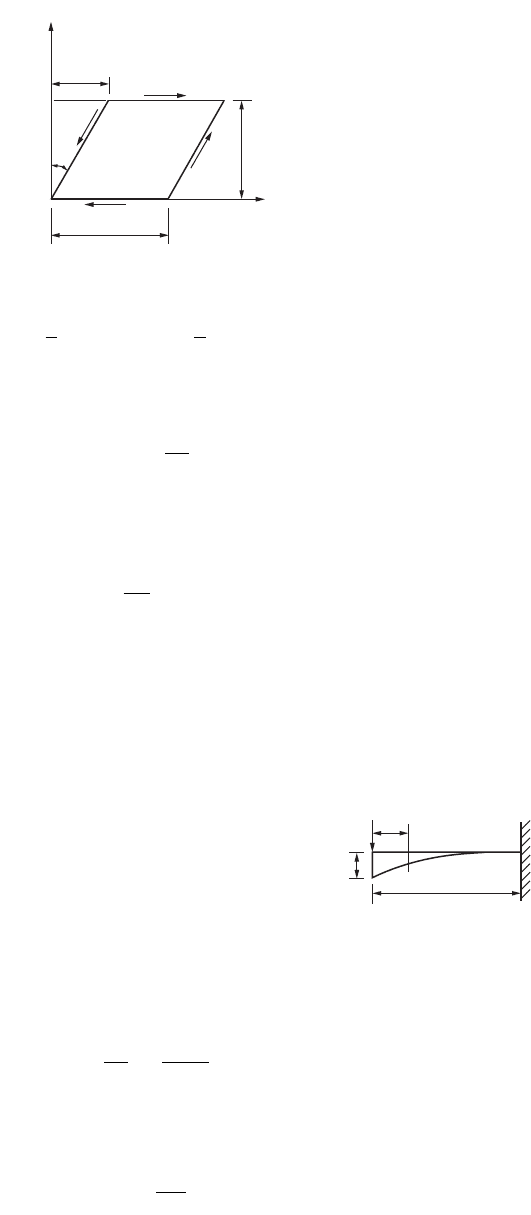
Theory and Analysis of Structures 47-71
(47.109)
Hooke’s law for shear stress and strain is
(47.110)
where G is the shear modulus of elasticity of the material. The expression for strain energy in shear
reduces to
(47.111)
The Energy Relations in Structural Analysis
The energy relations or laws, such as the law of conservation of energy, the theorem of virtual work, the
theorem of minimum potential energy, and the theorem of complementary energy, are of fundamental
importance in structural engineering and are used in various ways in structural analysis.
The Law of Conservation of Energy
The law of conservation of energy states that if a structure and the
external loads acting on it are isolated so that these neither receive nor
give out energy, then the total energy of this system remains constant.
A typical application of the law of conservation of energy can be
made by referring to Fig. 47.63, which shows a cantilever beam of
constant cross sections subjected to a concentrated load at its end. If
only bending strain energy is considered,
external work = internal work
Substituting M = –Px and integrating along the length gives
(47.112)
FIGURE 47.62 Shear loading.
A
B
Y
γ
xy
d
y
γ
xy
τ
xy
τ
xy
τ
yx
=
τ
xy
τ
yx
=
τ
xy
CX
dy
dx
dV
1
2
( dzdx) dy
1
2
dxdydz
xy
xy
xy
xy
==
t
g
t
g
xy
xy
G
g
t
=
dV
1
2G
dxdydz
xy
2
=
t
FIGURE 47.63 Cantilever beam.
P
x
L
EI = constant
P
2
M
dx
2EI
2
d
=
Ú
0
L
d=
3
PL
3EI
© 2003 by CRC Press LLC
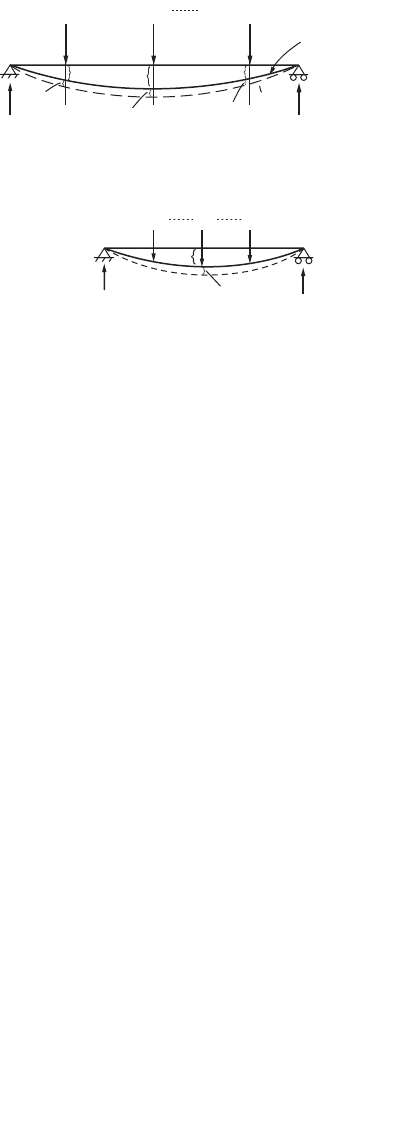
47-72 The Civil Engineering Handbook, Second Edition
The Theorem of Virtual Work
The theorem of virtual work can be derived by considering the beam shown in Fig. 47.64. The full curved
line represents the equilibrium position of the beam under the given loads. Assume the beam to be given
an additional small deformation consistent with the boundary conditions. This is called a virtual defor-
mation and corresponds to increments of deflection D
y1
, D
y2
, … , D
yn
at loads P
1
, P
2
, …, P
n
, as shown
by the dashed line.
The change in potential energy of the loads is given by
(47.113)
By the law of conservation of energy this must be equal to the internal strain energy stored in the beam.
Hence, we may state the theorem of virtual work as: if a body in equilibrium under the action of a system
of external loads is given any small (virtual) deformation, then the work done by the external loads
during this deformation is equal to the increase in internal strain energy stored in the body.
The Theorem of Minimum Potential Energy
Let us consider the beam shown in Fig. 47.65. The beam is in equilibrium under the action of loads P
1
,
P
2
, P
3
, …, P
i
, …, P
n
. The curve ACB defines the equilibrium positions of the loads and reactions. Now
apply by some means an additional small displacement to the curve so that it is defined by AC¢B. Let y
i
be the original equilibrium displacement of the curve beneath a particular load P
i
. The additional small
displacement is called d
yi
. The potential energy of the system while it is in the equilibrium configuration
is found by comparing the potential energy of the beam and loads in equilibrium and in the undeflected
position. If the change in potential energy of the loads is W and the strain energy of the beam is V, the
total energy of the system is
U = W + V (47.114)
If we neglect the second-order terms, then
(47.115)
The above is expressed as the principle or theorem of minimum potential energy, which can be stated
as: if all displacements satisfy given boundary conditions, those that satisfy the equilibrium conditions
make the potential energy a minimum.
FIGURE 47.64 Equilibrium of a simple supported beam under loading.
FIGURE 47.65 Simply supported beam under point loading.
R
1
y
1
P
1
P
2
P
n
Equilibrium
position of the
beam
R
2
∆y
1
∆y
2
∆y
n
y
2
y
n
R
L
P
1
A
C′
C
B
P
i
R
R
δy
i
y
i
P
n
D DP.E.
P
y
i=1
n
i
i
()
=
Â
ddUWV0=+
()
=
© 2003 by CRC Press LLC
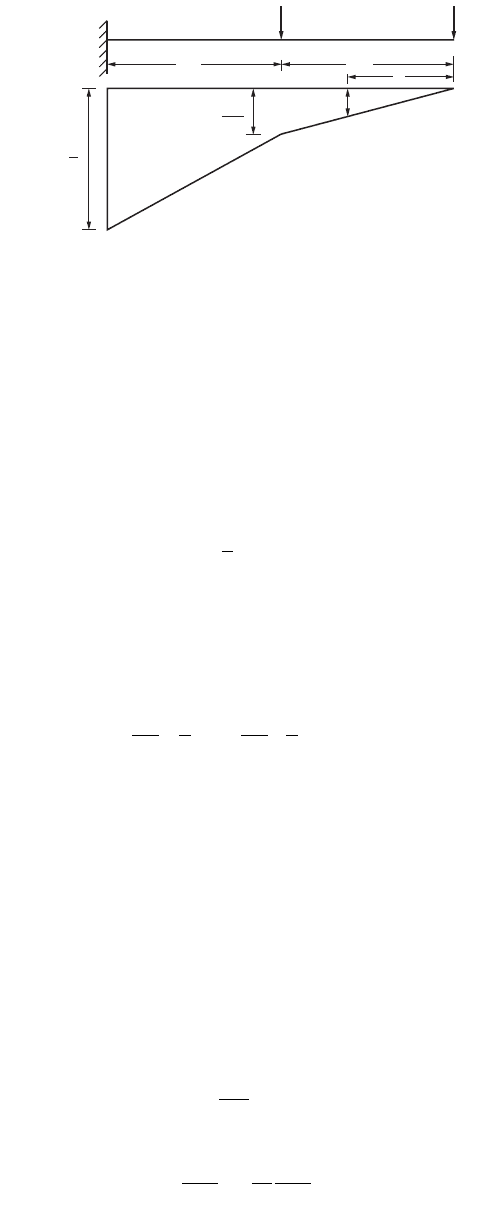
Theory and Analysis of Structures 47-73
Castigliano’s Theorem
This theorem applies only to structures stressed within the elastic limit, and all deformations must be
linear homogeneous functions of the loads.
For a beam in equilibrium, as in Fig. 47.64, the total potential energy is
(47.116)
For an elastic system, the strain energy, V, turns out to be one half the change in the potential energy of
the loads.
(47.117)
Castigliano’s theorem results from studying the variation in the strain energy, V, produced by a
differential change in one of the loads, say P
j
.
If the load P
j
is changed by a differential amount dP
j
and if the deflections y are linear functions of
the loads, then
(47.118)
Castigliano’s theorem states that the partial derivatives of the total strain energy of any structure with
respect to any one of the applied forces is equal to the displacement of the point of application of the
force in the direction of the force.
To find the deflection of a point in a beam that is not the point of application of a concentrated load,
one should apply a load P = 0 at that point and carry the term P into the strain energy equation. Finally,
introduce the true value of P = 0 into the expression for the answer.
Example 47.6
Determination of the bending deflection at the free end of a cantilever, loaded as shown in Fig. 47.66, is
required.
Solution:
FIGURE 47.66 Example 47.6.
W
2
l/2 l/2
W
1
W
1
x
W
1
l + W
2
l
2
W
1
l
2
EI Constant
x
UPyPy Py PyV
jj nn
=- + +º +º
[]
+
11 2 2
V
1
2
P
y
i=1
i=n
i
i
=
Â
∂
∂
∂
∂
V
P
P
y
P
yy
j
i
i
in
i
j
jj
=+=
=
=
Â
1
2
1
2
1
V
M
2EI
dx
0
2
=
==
Ú
Ú
L
L
V
W
M
EI
M
W
dxD
∂
∂
∂
∂
11
0
© 2003 by CRC Press LLC
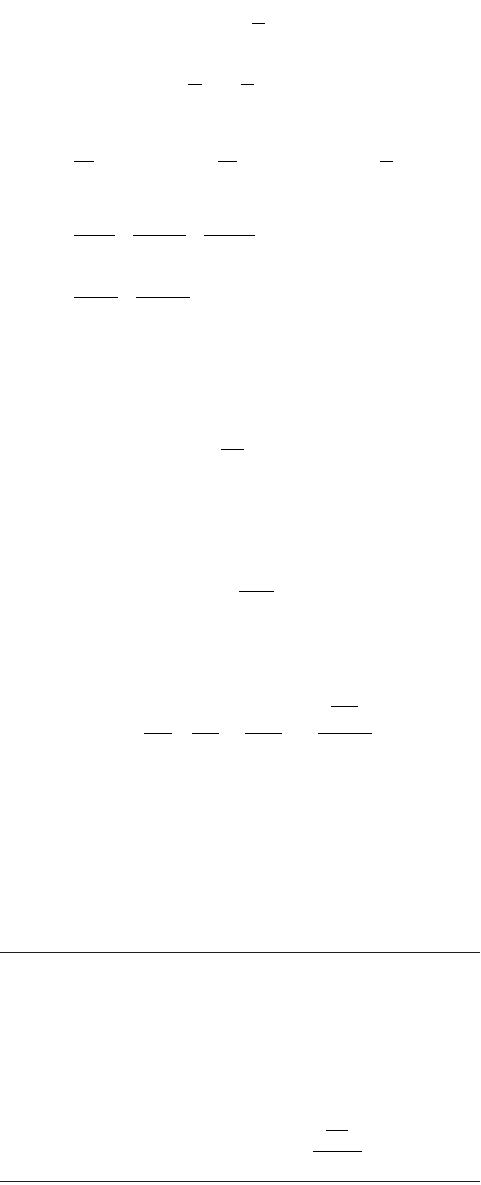
47-74 The Civil Engineering Handbook, Second Edition
Castigliano’s theorem can be applied to determine deflection of trusses as follows:
We know that the increment of strain energy for an axially loaded bar is given as
Substituting s
y
= S/A, where S is the axial load in the bar, and integrating over the length of the bar, the
total strain energy of the bar is given as
(47.119)
The deflection component D
i
of the point of application of a load P
i
in the direction of P
i
is given as
Example 47.7
Determine the vertical deflection at g of the truss subjected to three-point load, as shown in Fig. 47.67.
Let us first replace the 20 load at g by P and carry out the calculations in terms of P. At the end, P will
be replaced by the actual load of 20.
Member A L S n
nS
ab 2 25 –(33.3 + 0.83P) –0.83 2 (691 + 17.2P)
af 2 20 (26.7 + 0.67P) 0.67 2 (358 + 9P)
fg 2 20 (26.7 + 0.67P) 0.67 2 (358 + 9P)
bf 1 15 20 0 2 0
bg 1 25 0.83P 0.83 2 34.4P
bc 2 20 –26.7 – 1.33P –1.33 2 (710 + 35.4P)
cg 1 15 0 0 1 0
2117 + 105P
Note: n indicates the number of similar members.
MWx x
L
Wx W x
L
xL
EI
Wx xdx
EI
Wx w x
P
xdx
w
EI
W
EI
W
EI
W
EI
W
=<
=+ -
Ê
Ë
Á
ˆ
¯
˜
<<
=¥+ +-
Ê
Ë
Á
ˆ
¯
˜
È
Î
Í
˘
˚
˙
=+ +
=+
ÚÚ
1
12
1
0
12
2
1
3
1
3
2
3
1
3
2
3
0
2
22
11
2
24
7
24
5
48
3
5
2
l
lll
ll
ll
l
D
/
/
4848EI
dV
E
Ady
y
=
1
2
2
s
V
SL
AE
=
2
2
i
2
V
S
L
2AE
S
S
L
AE
D
=
∂
∂
=
∂
∂
Â=Â
∂
∂
PP
P
ii
i
dS
dP
------
dS
dP
------
L
A
---
S
S
P
L
A
d
d
Â
© 2003 by CRC Press LLC

Theory and Analysis of Structures 47-75
With P = 20,
Unit Load Method
The unit load method is a versatile tool in the solution of deflections of both trusses and beams. Consider
an elastic body in equilibrium under loads P
1
, P
2
, P
3
, P
4
, … P
n
and a load p applied at point O, as shown
in Fig. 47.68. By Castigliano’s theorem, the component of the deflection of point O in the direction of
the applied force p is
(47.120)
in which V is the strain energy of the body. It has been shown in Eq. (47.108) that the strain energy of
a beam, neglecting shear effects, is given by
Also it was shown that if the elastic body is a truss, from Eq. (47.119)
For a beam, therefore, from Eq. (47.120)
(47.121)
FIGURE 47.67 Example 47.7.
FIGURE 47.68 Elastic body in equilibrium under load.
30
15
b
a
A = 2
2
2
1
1
1
1
fgh 2
2
e
22
4 @ 20 = 80
20 20 20
cd2
30
E = 30 × 10
3
D
g
=Â =
+¥
()
¥
¥
=
S
S
P
L
AE
2117 105 20 12
30
1.69
d
d
10
3
d
o
p
=
∂
∂
V
p
V
O
=
Ú
L
M
EI
dx
2
2
V
S
L
2AE
2
=Â
d
o
p
=
∂
∂
Ú
L
M
M
p
dx
EI
P
1
P
2
P
n
0
P
1
(a)
(b)
0
© 2003 by CRC Press LLC

47-76 The Civil Engineering Handbook, Second Edition
and for a truss,
(47.122)
The bending moments M and the axial forces S are functions of the load p as well as of the loads P
1
,
P
2
, … P
n
. Let a unit load be applied at O on the elastic body and the corresponding moment be m if the
body is a beam and the forces in the members of the body u if the body is a truss. For the body in
Fig. 47.68 the moments M and the forces S due to the system of forces P
1
, P
2
, … P
n
and p at O applied
separately can be obtained by superposition as
(47.123)
(47.124)
in which M
p
and S
p
are, respectively, moments and forces produced by P
1
, P
2
, … P
n
.
Then
(47.125)
(47.126)
Using Eqs. (47.125) and (47.126) in Eqs. (47.121) and (47.122), respectively,
(47.127)
(47.128)
Example 47.8
Determine, using the unit load method, the deflection at C of a simple beam of constant cross section
loaded as shown in Fig. 47.69a.
Solution:
The bending moment diagram for the beam due to the applied loading is shown in Fig. 47.69b. A unit
load is applied at C, where it is required to determine the deflection, as shown in Fig. 47.69c; the
corresponding bending moment diagram is shown in Fig. 47.69d. Now, using Eq. (47.127), we have
d
o
p
=Â
∂
∂
S
S
p
L
AE
MM p
p
==m
SS p
p
=+u
∂
∂
==
M
p
m moments produced by a unit load at O
∂
∂
==
S
p
u stresses produced by a unit load at O
d
o
L
p
Mdx
EI
=
Ú
m
d
o
p
SuL
AE
=Â
d
c
o
o
L
Mdx
EI
EI
Wx x dx
EI
WL
Lxdx
L
L
L
=
=
()
Ê
Ë
Á
ˆ
¯
˜
+
Ê
Ë
Á
ˆ
¯
˜
-
()
Ú
ÚÚ
m
13
4
1
4
1
4
4
3
4
4
© 2003 by CRC Press LLC
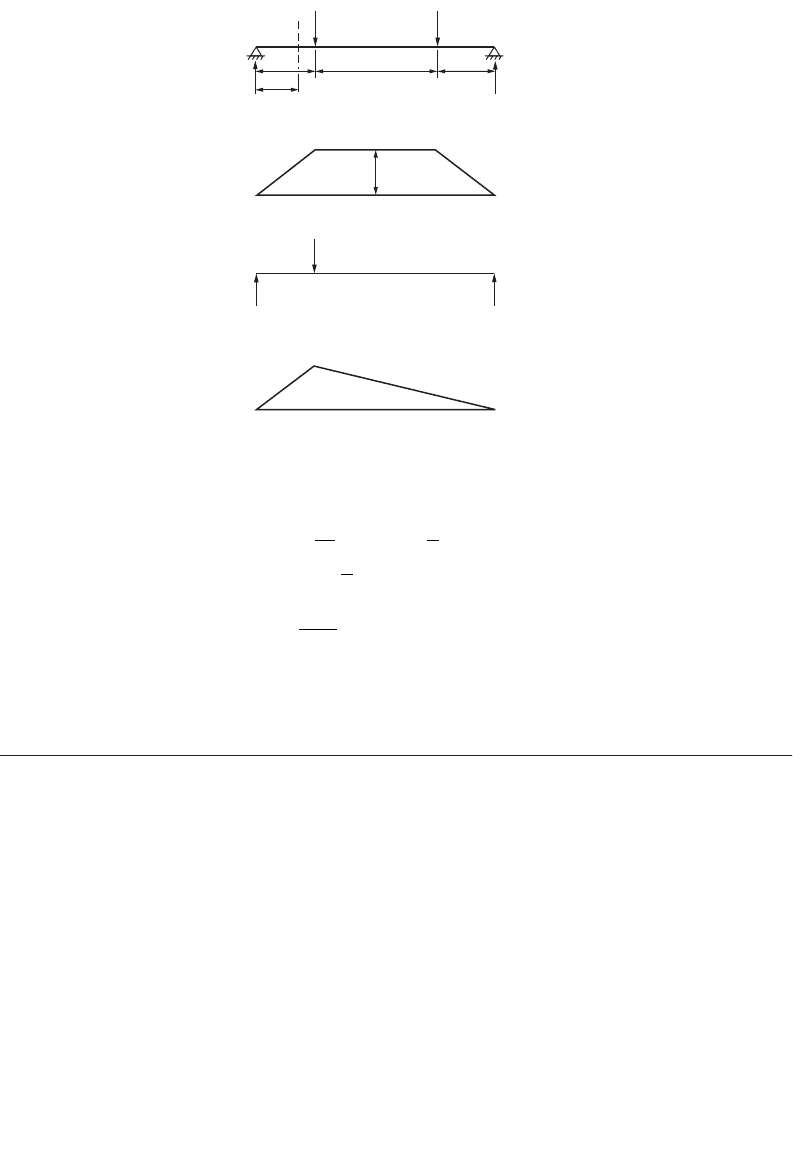
Theory and Analysis of Structures 47-77
Further details on energy methods in structural analysis may be found in Borg and Gennaro (1959).
47.9 Matrix Methods
In this method, a set of simultaneous equations that describe the load–deformation characteristics of the
structure under consideration are formed. These equations are solved using the matrix algebra to obtain
the load–deformation characteristics of discrete or finite elements into which the structure has been
subdivided. The matrix method is ideally suited for performing structural analysis using a computer. In
general, there are two approaches for structural analysis using the matrix analysis. The first is called the
flexibility method, in which forces are used as independent variables, and the second is called the stiffness
method, which employs deformations as the independent variables. The two methods are also called the
force method and the displacement method, respectively.
Flexibility Method
In this method, the forces and displacements are related to one another by using stiffness influence
coefficients. Let us consider, for example, a simple beam in which three concentrated loads, W
1
, W
2
, and
W
3
, are applied at sections 1, 2, and 3, respectively, as shown in Fig. 47.70. The deflection at section 1,
D
1
, can be expressed as
FIGURE 47.69 Example 47.8.
W
C
W
D
B
L/4 L/2
(a)
M = WL/4
WL/4
M = W (L − x)
M = Wx
(b)
m = 1/4 (L
− x)
m = 3/4x
(d)
L/4
A
x
3/4
1/4
(c)
1
+-
()
-
()
=
Ú
11
4
48
3
4
3
EI
WL x L xdx
WL
EI
L
L
D
1111122133
=++FW FW FW
© 2003 by CRC Press LLC
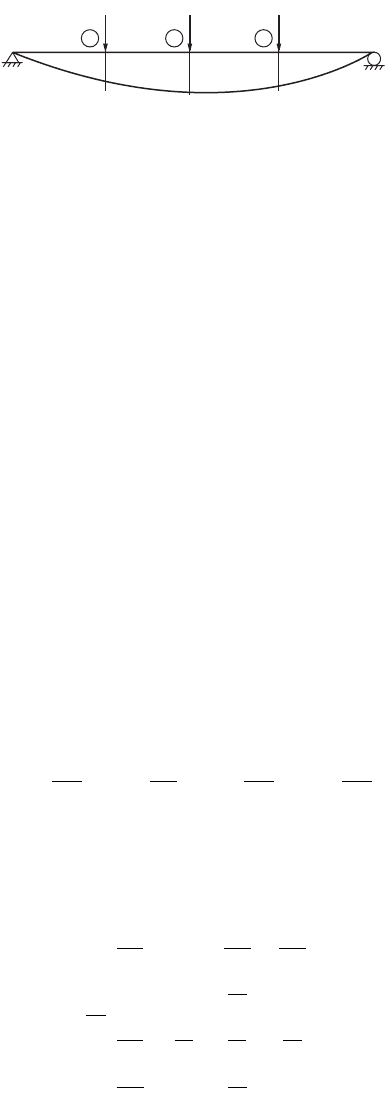
47-78 The Civil Engineering Handbook, Second Edition
in which F
11
, F
12
, and F
13
are called flexibility coefficients and are defined as the deflection at section 1
due to unit loads applied at sections 1, 2, and 3, respectively. Deflections at sections 2 and 3 are similarly
given as
and
(47.129)
These expressions are written in matrix form as
or
(47.130)
Matrix [F] is called the flexibility matrix. It can be shown, by applying Maxwell’s reciprocal theorem
(Borg and Gennaro, 1959), that matrix [F] is a symmetric matrix.
Let us consider a cantilever beam loaded as shown in Fig. 47.71. The first column in the flexibility
matrix can be generated by applying a unit vertical load at the free end of the cantilever, as shown in
Fig. 47.71b, and making use of the moment area method. We get
Columns 2, 3, and 4 are similarly generated by applying unit moment at the free end and unit force and
unit moment at the midspan, as shown in Figs. 47.71c to e, respectively. Combining the results, the
flexibility matrix can be formed as
(47.131)
For a given structure, it is necessary to subdivide the structure into several elements and to form the
flexibility matrix for each of the elements. The flexibility matrix for the entire structure is then obtained
by combining the flexibility matrices of the individual elements.
FIGURE 47.70 Simple beam under concentrated loads.
W
1
∆
1
∆
2
∆
3
W
2
W
3
1 2 3
D
2211222233
=++FW FW FW
D
3311322333
=++FW FW FW
D
D
D
1
2
3
11 12 13
21 22 23
31 32 33
1
2
3
Ï
Ì
Ô
Ó
Ô
¸
˝
Ô
˛
Ô
=
È
Î
Í
Í
Í
˘
˚
˙
˙
˙
Ï
Ì
Ô
Ó
Ô
¸
˝
Ô
˛
Ô
FFF
FFF
FFF
W
W
W
D
{}
=
[]
{}
FW
F
L
EI
F
L
EI
F
L
EI
F
L
EI
11
3
21
2
31
3
41
2
8
3
25
6
3
2
====, , ,
D
D
D
D
1
2
3
4
3
2
32
2
2
32 3 2
22
1
2
3
4
1
8
3
2
5
6
3
2
22
2
5
6232
3
22
Ï
Ì
Ô
Ô
Ó
Ô
Ô
¸
˝
Ô
Ô
˛
Ô
Ô
=
È
Î
Í
Í
Í
Í
Í
Í
Í
Í
Í
˘
˚
˙
˙
˙
˙
˙
˙
˙
˙
˙
Ï
Ì
Ô
Ô
Ó
Ô
Ô
¸
˝
Ô
Ô
˛
Ô
Ô
EI
L
L
LL
LL
L
L
LL L L
L
L
L
L
W
W
W
W
© 2003 by CRC Press LLC
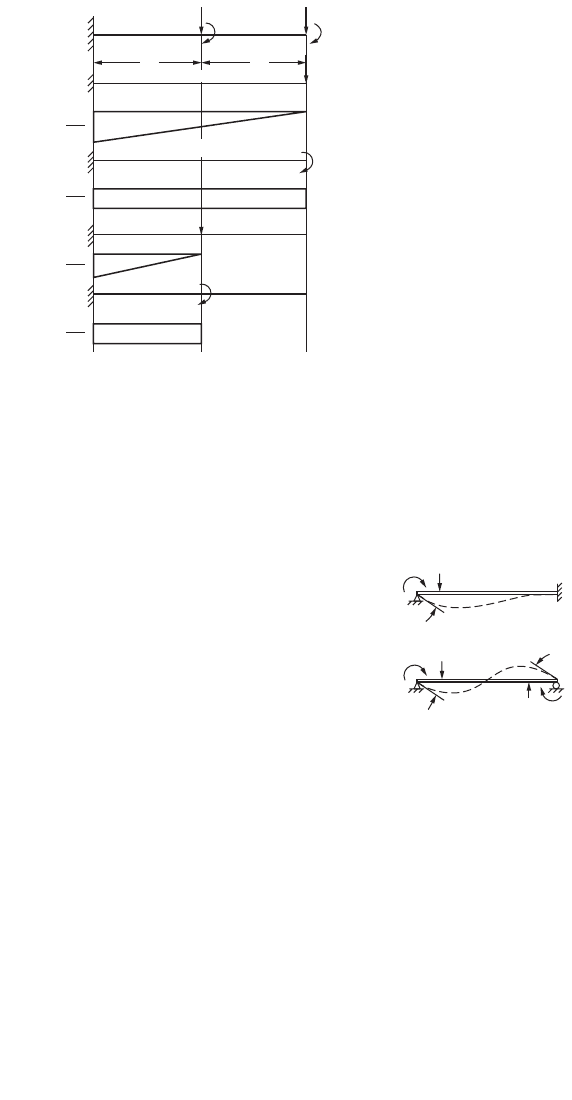
Theory and Analysis of Structures 47-79
The force transformation matrix relates what occurs in these elements to the behavior of the entire
structure. Using the conditions of equilibrium, it relates the element forces to the structure forces. The
principle of conservation of energy may be used to generate transformation matrices.
Stiffness Method
In this method, forces and deformations in a structure are
related to one another by means of stiffness influence coeffi-
cients. Let us consider a simply supported beam subjected to
end moments W
1
and W
2
applied at supports 1 and 2, respec-
tively, and let the rotations be denoted as D
1
and D
2
, as shown
in Fig. 47.72. We can now write the expressions for end
moments W
1
and W
2
as
(47.132)
in which K
11
and K
12
are called stiffness influence coefficients defined as moments at 1 due to unit rotation
at 1 and 2, respectively. The above equations can be written in matrix form as
or
(47.133)
Matrix [K] is referred to as the stiffness matrix. It can be shown that the flexibility matrix of a structure
is the inverse of the stiffness matrix and vice versa. The stiffness matrix of the whole structure is formed
out of the stiffness matrices of the individual elements that make up the structure.
FIGURE 47.71 Cantilever beam.
1
1
LL
(c)
(d)
(e)
(b)
(a)
W
2
, ∆
2
W
4
, ∆
4
W
1
, ∆
1
W
3
, ∆
3
1
1
EI
2L
EI
1
EI
1
EI
L
FIGURE 47.72 Simply supported beam.
W
1
1
2
(a)
∆
1
W
1
W
2
1
2
(b)
∆
1
∆
2
WK K
WK K
111112 2
221122 2
=+
=+
DD
DD
W
W
KK
KK
1
2
11 12
21 22
2
2
Ï
Ì
Ó
¸
˝
˛
=
È
Î
Í
˘
˚
˙
Ï
Ì
Ó
¸
˝
˛
D
D
WK
{}
=
[]
{}
D
© 2003 by CRC Press LLC

47-80 The Civil Engineering Handbook, Second Edition
Element Stiffness Matrix
Axially Loaded Member
Figure 47.73 shows an axially loaded member of a constant cross-sectional area with element forces q
1
and q
2
and displacements d
1
and d
2
. They are shown in their respective positive directions. With unit
displacement d
1
= 1 at node 1, as shown in Fig. 47.73, axial forces at nodes 1 and 2 are obtained as
In the same way, by setting d
2
= 1, as shown in Fig. 47.73, the corresponding forces are obtained as
The stiffness matrix is written as
or
(47.134)
Flexural Member
The stiffness matrix for the flexural element can be constructed by referring to Fig. 47.74. The forces and
the corresponding displacements viz. the moments, shears, and corresponding rotations and translations
at the ends of the member are defined in the figure. The matrix equation that relates these forces and
displacements can be written in the form
FIGURE 47.73 Axially loaded member.
L
(a)
(b)
(c)
q
1
,δ
1
q
2
,δ
2
1
Axially loaded element
2
k
11
k
21
δ
1
=
1
δ
2
=
0
12
δ
2
=
1
δ
1
=
0
k
12
k
22
1
2
K
K
11
==-
EA
L
,
EA
L
21
K
EA
L
K
EA
L
12 22
=- =,
q
q
KK
KK
1
2
11 12
21 22
1
2
Ï
Ì
Ó
¸
˝
˛
=
È
Î
Í
˘
˚
˙
Ï
Ì
Ó
¸
˝
˛
d
d
q
q
EA
L
1
2
1
2
11
11
Ï
Ì
Ó
¸
˝
˛
=
-
-
È
Î
Í
˘
˚
˙
Ï
Ì
Ó
¸
˝
˛
d
d
q
q
q
q
K KKK
K KKK
K KKK
K KKK
1
2
3
4
11 12 13 14
21 22 23 24
31 32 33 34
41 42 43 44
1
2
3
4
È
Î
Í
Í
Í
Í
Í
˘
˚
˙
˙
˙
˙
˙
=
È
Î
Í
Í
Í
Í
Í
˘
˚
˙
˙
˙
˙
˙
È
Î
Í
Í
Í
Í
Í
˘
˚
˙
˙
˙
˙
˙
d
d
d
d
© 2003 by CRC Press LLC
